Search for Secret Chambers in King Tut's Tomb Begins
Discovery News
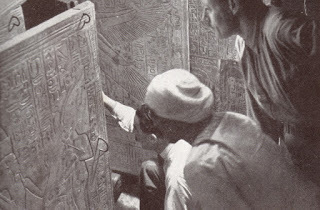 Howard Carter opens King Tut’s tomb.Harry Burton/Wikimedia Commons
Howard Carter opens King Tut’s tomb.Harry Burton/Wikimedia Commons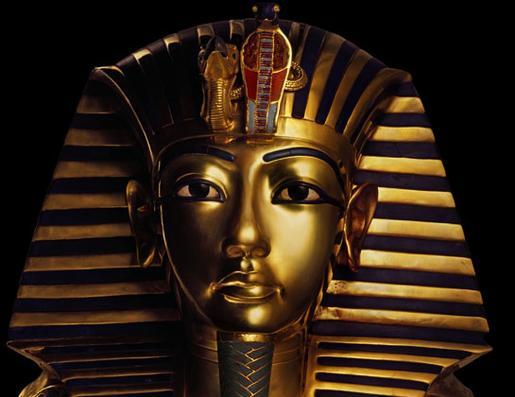
 Gallery InsideKingTut'sTombView Caption +#1: King Tut's Mask
Gallery InsideKingTut'sTombView Caption +#1: King Tut's Mask
"Tutankhamun: His Tomb and the Treasures" is a new exhibition now in Zurich that has meticulously reconstructed the tomb complex and its treasures. Specially trained craftspeople in Cairo built more than 1,000 exact replicas under scientific supervision. The work took over five years. Here is a replica of the famous mask of King Tut, weighing 24 lbs, which was pressed over the head of the king's bandaged mummy. The idealized portrait of the young king echoes the style of the late Amarna period. The life-like eyes are formed by bright quartz, with obsidian inlays for the pupils.
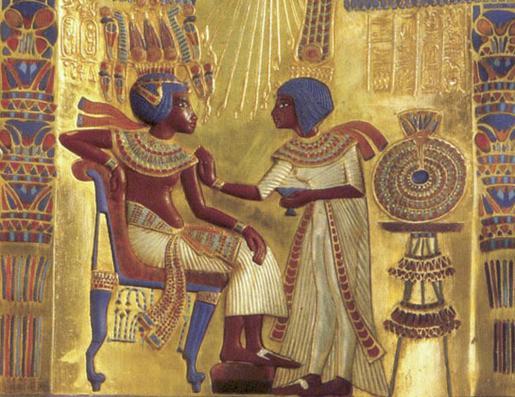 View Caption +#2: King Tut, With Wife This scene, depicted on the backrest of King Tut's throne, shows how Tutankhamen used to lean back in a relaxed manner while his wife, Anchesenamun, stood beside him and rubbed ointment into his shoulder.
View Caption +#2: King Tut, With Wife This scene, depicted on the backrest of King Tut's throne, shows how Tutankhamen used to lean back in a relaxed manner while his wife, Anchesenamun, stood beside him and rubbed ointment into his shoulder.
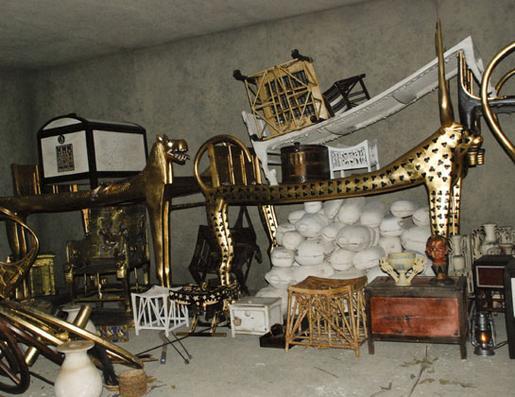 View Caption +#3: Tomb Discovery This is how the tomb of the boy king Tutankhamun appeared to archaeologist Howard Carter when he discovered it in 1922.
View Caption +#3: Tomb Discovery This is how the tomb of the boy king Tutankhamun appeared to archaeologist Howard Carter when he discovered it in 1922.
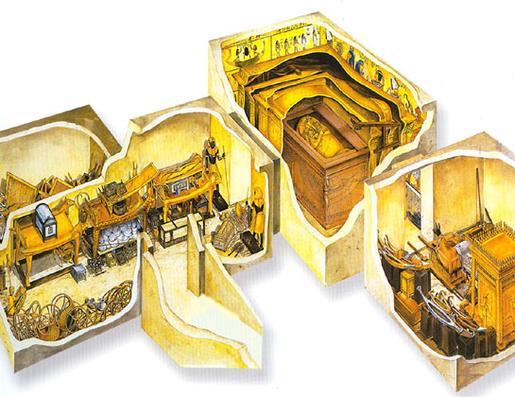 View Caption +#4: King Tut's Tomb in 3-D Tutankhamun's tomb and its contents, as viewed in a 3-D model. A corridor led to an antechamber and an annex filled with objects. The antechamber opened into the coffin chamber with King Tut's sarcophagus. The coffin chamber led to another small room filled with King Tut's treasures.
View Caption +#4: King Tut's Tomb in 3-D Tutankhamun's tomb and its contents, as viewed in a 3-D model. A corridor led to an antechamber and an annex filled with objects. The antechamber opened into the coffin chamber with King Tut's sarcophagus. The coffin chamber led to another small room filled with King Tut's treasures.
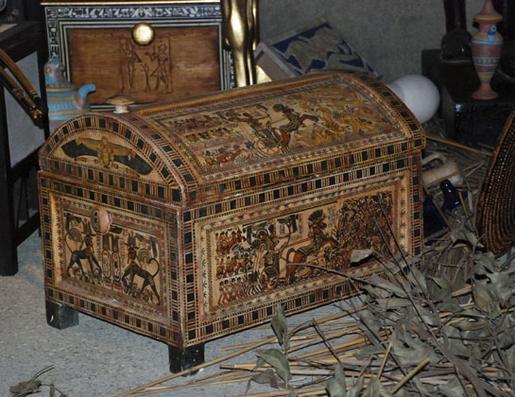 View Caption +#5: Treasures Galore Two tiny mummified female fetuses were found in the tomb with the king. But they were not the only companions placed in the tomb for King Tut's journey to the afterlife. The boy king was buried with more than 5,000 priceless objects, including this treasure chest.
View Caption +#5: Treasures Galore Two tiny mummified female fetuses were found in the tomb with the king. But they were not the only companions placed in the tomb for King Tut's journey to the afterlife. The boy king was buried with more than 5,000 priceless objects, including this treasure chest.
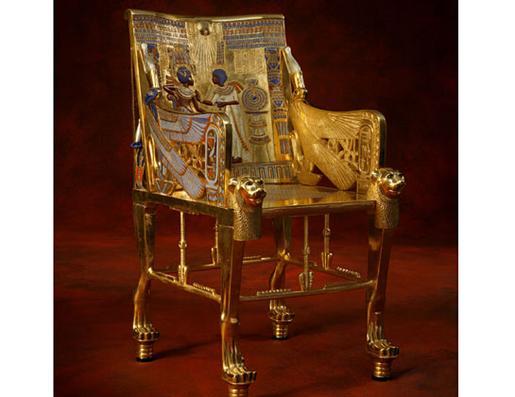 View Caption +#6: Boy Throne The famous gold throne found in the tomb was ordered when Tutankhamen became king at the age of nine.
View Caption +#6: Boy Throne The famous gold throne found in the tomb was ordered when Tutankhamen became king at the age of nine.
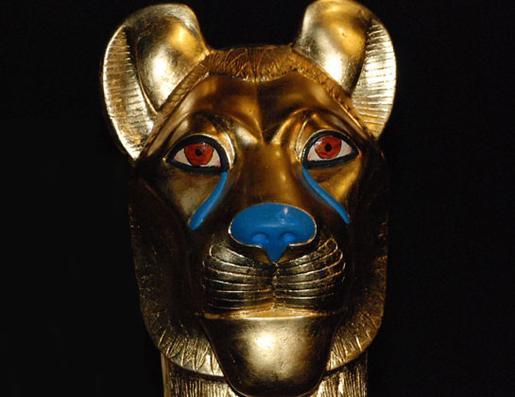 View Caption +#7: Lion Head The dead king in the underworld was akin to the sun at night and, in the New Kingdom, this was identified with the god of death, Osiris. The heads of lions corresponded to the time the sun god spent in the body of the god of heaven in feline form. The facial details of the lion head –- the rims of the eyes, tip of the nose and tear ducts -- are given almost life-like properties through the use of glass.
View Caption +#7: Lion Head The dead king in the underworld was akin to the sun at night and, in the New Kingdom, this was identified with the god of death, Osiris. The heads of lions corresponded to the time the sun god spent in the body of the god of heaven in feline form. The facial details of the lion head –- the rims of the eyes, tip of the nose and tear ducts -- are given almost life-like properties through the use of glass.
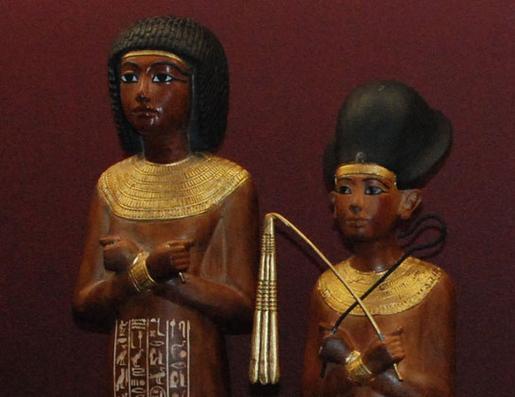 View Caption +#8: Hired Help for the Afterlife These figures were supposed to take the place of the king in performing the daily tasks that came up in the afterlife. A total of 413 of these figures, known as ushabtis, were found in Tutankhamun's tomb. Among the collection, 365 were responsible for carrying out day-to-day duties, 36 ushabtis served as overseers for groups of 10 workers each, and 12 acted as monthly supervisors
View Caption +#8: Hired Help for the Afterlife These figures were supposed to take the place of the king in performing the daily tasks that came up in the afterlife. A total of 413 of these figures, known as ushabtis, were found in Tutankhamun's tomb. Among the collection, 365 were responsible for carrying out day-to-day duties, 36 ushabtis served as overseers for groups of 10 workers each, and 12 acted as monthly supervisors
An investigation of King Tut’s tomb to find secret chambers will begin tomorrow and will last until Friday, Egypt’s Minister of Antiquity announced on Wednesday.
The announcement, reported in the Egyptian media, comes on the 93rd anniversary of the tomb’s discovery in the Valley of the Kings in Luxor. On this day in 1922, British archaeologist Howard Carter found the entrance to King Tutankhamun’s treasure-filled tomb.
A team from Cairo University’s Faculty of Engineering and the Paris-based organization Heritage, Innovation and Preservation will investigate the tomb using infrared thermography.
PHOTOS: Inside King Tut's Tomb
The non-invasive search follows a claim by Nicholas Reeves, a British Egyptologist at the University of Arizona, that high-resolution images of the tomb’s walls show “distinct linear traces” pointing to the presence of two still unexplored chambers behind the western and northern walls of the tomb.
According to Reeves, one chamber contains the remains, and possibly the intact grave goods, of queen Nefertiti, the wife of the “heretic” monotheistic pharaoh Akhenaten, Tutankhamun’s father.
He argued that a painting located behind King Tut’s sarcophagus has been wrongly interpreted. Egyptologists have always believed the scene shows Ay (who largely directed King Tut’s reign and succeeded him) performing the Opening of the Mouth ritual on the boy king.
Tut’s Funeral: Burying the Boy King
Reeves believes the figure labelled Tutankhamun is actually Nefertiti. He noted that a line at the side of the figure’s mouth, called “oromental groove,” is a trademark in pictures of Nefertiti. On the other hand, the figure labelled Ay would be Tutankhamun, completing the death ritual for Nefertiti.
Reeves speculated that the tomb of King Tut was not ready when he died unexpectedly at 19 in 1323 B.C. after having ruled a short reign of nine to 10 years. Consequently, he was buried in a rush in what was originally Nefertiti’s tomb, who had died 10 years earlier.
An examination of King Tut’s tomb in September revealed several unusual features, such as a contrast in the materials that cover different parts of the same wall and an extended ceiling which suggests King Tut’s burial chamber was originally a corridor.
Weird Facts About King Tut and His Mummy
After the visual examination, Egypt’s Antiquities minister Mamdouh al-Damaty agreed it was very likely that there were hidden chambers in the tomb.
However, he disagreed with Reeves on the Nefertiti claim.
An international team of researchers led by mummy expert Frank Rühli, director of the Institute of Evolutionary Medicine at the University of Zurich, also cautioned last month about the possibility of Nefertiti being the occupant of the secret crypt.
“Queen Nefertiti might be the already found Younger Lady,” Rühli said.
Who Else May Be in King Tut’s Tomb?
The “Younger Lady” is a mummy found in 1898 by archaeologist Victor Loret in tomb KV35 in the Valley of the Kings.
Nefertiti is labelled in inscriptions to be Tutankhamun’s mother; genetic analyses identified the “Younger Lady” as the mother of Tutankhamun.
Such evidence would automatically rule out Nefertiti, the researchers concluded.
King Tut Felled by Malaria, Bone Disease
If a mummy is found, it could belong to the elusive pharaoh Smenkhkare, or to queen Meritaton, the full or half sister of Tutankhamun, they added.
It is also possible that nothing at all will be found behind those walls.
“The possible findings range from nothing at all or unfinished and closed corridors to storage chambers or intact burials with treasures,” Rühli told Discovery News.
by Rossella Lorenzi
 Howard Carter opens King Tut’s tomb.Harry Burton/Wikimedia Commons
Howard Carter opens King Tut’s tomb.Harry Burton/Wikimedia Commons
 Gallery InsideKingTut'sTombView Caption +#1: King Tut's Mask
Gallery InsideKingTut'sTombView Caption +#1: King Tut's Mask"Tutankhamun: His Tomb and the Treasures" is a new exhibition now in Zurich that has meticulously reconstructed the tomb complex and its treasures. Specially trained craftspeople in Cairo built more than 1,000 exact replicas under scientific supervision. The work took over five years. Here is a replica of the famous mask of King Tut, weighing 24 lbs, which was pressed over the head of the king's bandaged mummy. The idealized portrait of the young king echoes the style of the late Amarna period. The life-like eyes are formed by bright quartz, with obsidian inlays for the pupils.
 View Caption +#2: King Tut, With Wife This scene, depicted on the backrest of King Tut's throne, shows how Tutankhamen used to lean back in a relaxed manner while his wife, Anchesenamun, stood beside him and rubbed ointment into his shoulder.
View Caption +#2: King Tut, With Wife This scene, depicted on the backrest of King Tut's throne, shows how Tutankhamen used to lean back in a relaxed manner while his wife, Anchesenamun, stood beside him and rubbed ointment into his shoulder. View Caption +#3: Tomb Discovery This is how the tomb of the boy king Tutankhamun appeared to archaeologist Howard Carter when he discovered it in 1922.
View Caption +#3: Tomb Discovery This is how the tomb of the boy king Tutankhamun appeared to archaeologist Howard Carter when he discovered it in 1922. View Caption +#4: King Tut's Tomb in 3-D Tutankhamun's tomb and its contents, as viewed in a 3-D model. A corridor led to an antechamber and an annex filled with objects. The antechamber opened into the coffin chamber with King Tut's sarcophagus. The coffin chamber led to another small room filled with King Tut's treasures.
View Caption +#4: King Tut's Tomb in 3-D Tutankhamun's tomb and its contents, as viewed in a 3-D model. A corridor led to an antechamber and an annex filled with objects. The antechamber opened into the coffin chamber with King Tut's sarcophagus. The coffin chamber led to another small room filled with King Tut's treasures. View Caption +#5: Treasures Galore Two tiny mummified female fetuses were found in the tomb with the king. But they were not the only companions placed in the tomb for King Tut's journey to the afterlife. The boy king was buried with more than 5,000 priceless objects, including this treasure chest.
View Caption +#5: Treasures Galore Two tiny mummified female fetuses were found in the tomb with the king. But they were not the only companions placed in the tomb for King Tut's journey to the afterlife. The boy king was buried with more than 5,000 priceless objects, including this treasure chest. View Caption +#6: Boy Throne The famous gold throne found in the tomb was ordered when Tutankhamen became king at the age of nine.
View Caption +#6: Boy Throne The famous gold throne found in the tomb was ordered when Tutankhamen became king at the age of nine. View Caption +#7: Lion Head The dead king in the underworld was akin to the sun at night and, in the New Kingdom, this was identified with the god of death, Osiris. The heads of lions corresponded to the time the sun god spent in the body of the god of heaven in feline form. The facial details of the lion head –- the rims of the eyes, tip of the nose and tear ducts -- are given almost life-like properties through the use of glass.
View Caption +#7: Lion Head The dead king in the underworld was akin to the sun at night and, in the New Kingdom, this was identified with the god of death, Osiris. The heads of lions corresponded to the time the sun god spent in the body of the god of heaven in feline form. The facial details of the lion head –- the rims of the eyes, tip of the nose and tear ducts -- are given almost life-like properties through the use of glass. View Caption +#8: Hired Help for the Afterlife These figures were supposed to take the place of the king in performing the daily tasks that came up in the afterlife. A total of 413 of these figures, known as ushabtis, were found in Tutankhamun's tomb. Among the collection, 365 were responsible for carrying out day-to-day duties, 36 ushabtis served as overseers for groups of 10 workers each, and 12 acted as monthly supervisors
View Caption +#8: Hired Help for the Afterlife These figures were supposed to take the place of the king in performing the daily tasks that came up in the afterlife. A total of 413 of these figures, known as ushabtis, were found in Tutankhamun's tomb. Among the collection, 365 were responsible for carrying out day-to-day duties, 36 ushabtis served as overseers for groups of 10 workers each, and 12 acted as monthly supervisorsAn investigation of King Tut’s tomb to find secret chambers will begin tomorrow and will last until Friday, Egypt’s Minister of Antiquity announced on Wednesday.
The announcement, reported in the Egyptian media, comes on the 93rd anniversary of the tomb’s discovery in the Valley of the Kings in Luxor. On this day in 1922, British archaeologist Howard Carter found the entrance to King Tutankhamun’s treasure-filled tomb.
A team from Cairo University’s Faculty of Engineering and the Paris-based organization Heritage, Innovation and Preservation will investigate the tomb using infrared thermography.
PHOTOS: Inside King Tut's Tomb
The non-invasive search follows a claim by Nicholas Reeves, a British Egyptologist at the University of Arizona, that high-resolution images of the tomb’s walls show “distinct linear traces” pointing to the presence of two still unexplored chambers behind the western and northern walls of the tomb.
According to Reeves, one chamber contains the remains, and possibly the intact grave goods, of queen Nefertiti, the wife of the “heretic” monotheistic pharaoh Akhenaten, Tutankhamun’s father.
He argued that a painting located behind King Tut’s sarcophagus has been wrongly interpreted. Egyptologists have always believed the scene shows Ay (who largely directed King Tut’s reign and succeeded him) performing the Opening of the Mouth ritual on the boy king.
Tut’s Funeral: Burying the Boy King
Reeves believes the figure labelled Tutankhamun is actually Nefertiti. He noted that a line at the side of the figure’s mouth, called “oromental groove,” is a trademark in pictures of Nefertiti. On the other hand, the figure labelled Ay would be Tutankhamun, completing the death ritual for Nefertiti.
Reeves speculated that the tomb of King Tut was not ready when he died unexpectedly at 19 in 1323 B.C. after having ruled a short reign of nine to 10 years. Consequently, he was buried in a rush in what was originally Nefertiti’s tomb, who had died 10 years earlier.
An examination of King Tut’s tomb in September revealed several unusual features, such as a contrast in the materials that cover different parts of the same wall and an extended ceiling which suggests King Tut’s burial chamber was originally a corridor.
Weird Facts About King Tut and His Mummy
After the visual examination, Egypt’s Antiquities minister Mamdouh al-Damaty agreed it was very likely that there were hidden chambers in the tomb.
However, he disagreed with Reeves on the Nefertiti claim.
An international team of researchers led by mummy expert Frank Rühli, director of the Institute of Evolutionary Medicine at the University of Zurich, also cautioned last month about the possibility of Nefertiti being the occupant of the secret crypt.
“Queen Nefertiti might be the already found Younger Lady,” Rühli said.
Who Else May Be in King Tut’s Tomb?
The “Younger Lady” is a mummy found in 1898 by archaeologist Victor Loret in tomb KV35 in the Valley of the Kings.
Nefertiti is labelled in inscriptions to be Tutankhamun’s mother; genetic analyses identified the “Younger Lady” as the mother of Tutankhamun.
Such evidence would automatically rule out Nefertiti, the researchers concluded.
King Tut Felled by Malaria, Bone Disease
If a mummy is found, it could belong to the elusive pharaoh Smenkhkare, or to queen Meritaton, the full or half sister of Tutankhamun, they added.
It is also possible that nothing at all will be found behind those walls.
“The possible findings range from nothing at all or unfinished and closed corridors to storage chambers or intact burials with treasures,” Rühli told Discovery News.
by Rossella Lorenzi
Published on November 08, 2015 03:00
No comments have been added yet.



